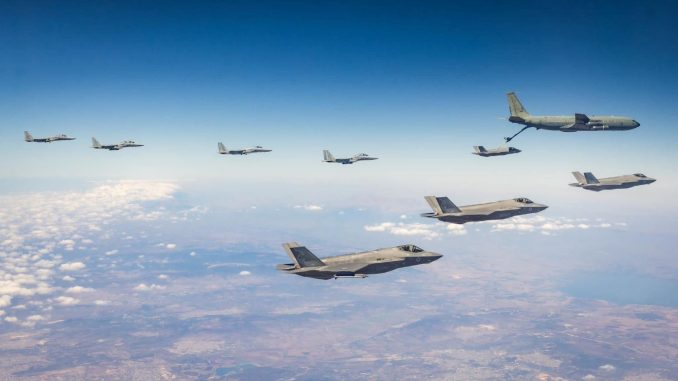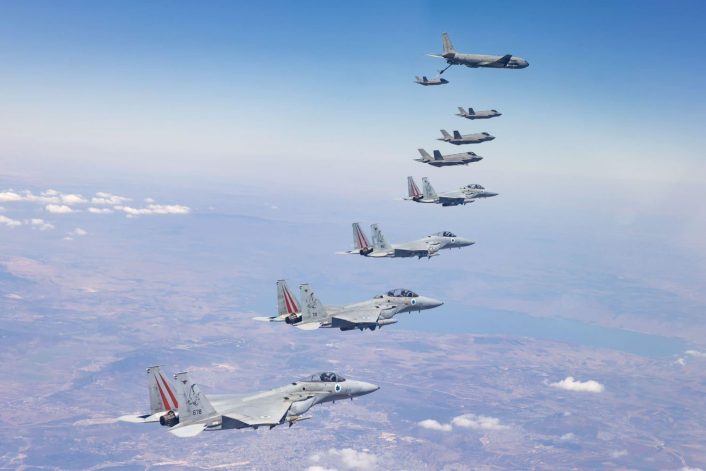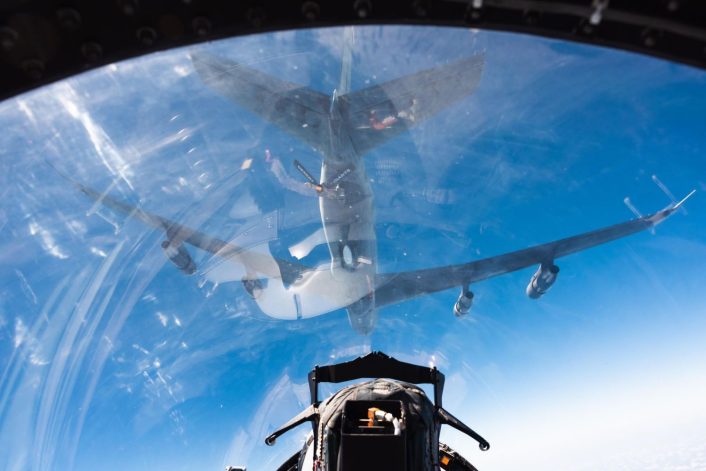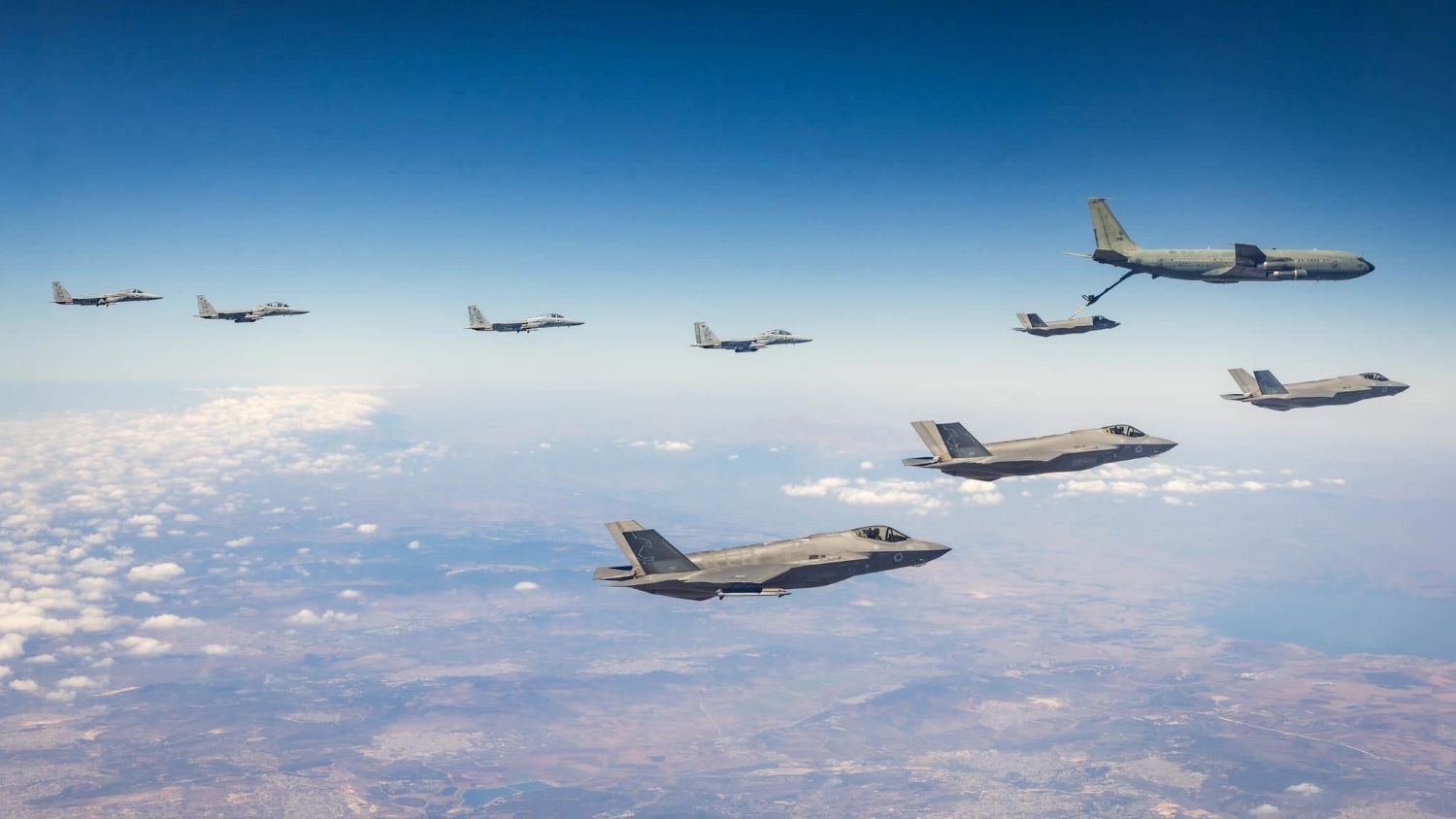
Amid rising tensions with Iran, Israel is showcasing its aviation capabilities with an exercise simulating a “long-range flight deep into enemy territory” supported by aerial refueling.
On August 15, 2024, the Israeli Air Force conducted an aerial refueling exercise using its 707 “Re’em” tanker aircraft and F-35I “Adir” and F-15C/D “Baz” fighter jets. A highly unusual aspect of the exercise was that the receiving aircraft were all armed with live weapons.
“The exercise simulated long-distance flights deep behind enemy lines, conducting aerial refueling in short periods of time. Aerial refueling is an operational capability required by combat troops to remain airborne for long periods of time,” the Israeli Air Force said in social media posts.
The exercise
In images released by the Israel Defense Forces, the IAF displays a variety of weapons systems. The McDonnell Douglas F-15C “Baz”, the single-seat variant of the most successful fighter aircraft of all time, is equipped with GBU-31 Joint Direct Attack Munitions (JDAM), while the F-15D (two-seat model) carries the AGM-142 “Popeye”. The AGM-142 is an Israeli-made air-to-ground standoff missile, while a JDAM is a kit that can be used to convert a “dumb” (or unguided) bomb into a precision munition.
Although they simulate a long-range attack, the F-15s are not equipped with the usual external fuel tanks (600 gallons). This is because the underwing stations 2 and 8 are loaded with the heavy weapons and the centerline station (5) of the two-seat aircraft is loaded with Popeye’s data link capsule.
Apparently as part of preparations for a possible attack on Iran, the Israeli Air Force conducted a long-range refueling exercise yesterday.
In a statement, the Israeli army said the exercise “simulated a long-distance flight deep into enemy territory while simultaneously conducting multiple aerial refuelings…” pic.twitter.com/w7mq8YZELV
— Emanuel (Mannie) Fabian (@manniefabian) 16 August 2024
However, the Bazs are equipped with the Conformal Fuel Tanks or FAST (Fuel And Sensor Tactical) packs normally found on the F-15E Strike Eagle and F-15I Ra’am, which can carry 750 gallons of fuel while also having six attachment points for weapons and two for the sensors.
Unlike traditional external fuel tanks, the FAST packs cannot be jettisoned during flight, but do not unduly affect the F-15’s performance. In fact, they allow the same maneuverability without limitations imposed by g-loads, with the only structural limitation being not to exceed Mach 2 speed (the F-15’s reported maximum speed is Mach 2.5).

In the released images, we also see Israel’s newest fighter jet, the F-35I “Adir”, flying in “full stealth mode” without radar reflectors. Notably, the Israeli Air Force has previously claimed its F-35s could reach Iran without refueling. The claim was vague and without many details, but it was believed to refer to new, “stealth” drop tanks, or Conformal Fuel Tanks (CFT).
It is no secret that the Israeli Air Force considers range to be one of the most important factors when introducing a new fighter aircraft and that is why it was the first operator to request external fuel tanks for the F-35 Lightning II. However, the new alleged tanks were never shown publicly and details were never disclosed.
Also notable is that one of the F-35s carries an AIM-9X Sidewinder air-to-air missile on an external rail. The Adir recently completed its first air-to-air kill when it intercepted a Houthi cruise missile in 2023. Even more recently, the warplanes were involved in Israel’s first strikes in Yemen, a retaliatory strike against Houthi forces.
As for the tanker, Israel’s Boeing 707s have been in service for around 60 years and will eventually be replaced by four brand new KC-46A Pegasus tanker aircraft. The 707s were originally airliners and were later converted locally to tankers. As with many of its aircraft, the IAF is very secretive about the exact capabilities and even the number of KC-707s it operates.
הזרוע הארוכה של צה״ל: חיל-האוויר תירגל אתמול תדלוקים אוויריים של מ. טוסי קרב במרחב האווירי של ישראל.
התרגיל דימה טיסה בטווחים ארוכים בעומק שטח האויב, תוך תדלוק אווירי, מספר פעמים, בפרקי זמן קצרים. בתרגיל השתתפו מטוסי ״אדיר״, ״בז״ ומטוס “ראם” תדלוק אווירי. pic.twitter.com/LXYBaIy8pZ
— Israeli Air Force (@IAFsite) 16 August 2024
Aerial refueling is a vitally important part of modern military operations, and Israel is no exception, even when fighting in its own backyard. It has used a combination of purpose-built tanker aircraft such as the KC-707, KC-130H, and historically the KC-97, with tanker aircraft such as the F-4E and A-4H.
While further details of the exercise were not disclosed, it appears to be similar to drills conducted in previous years. For example, the 2022 drills included “long-range flights, aerial refueling and attacks on distant targets,” with more than 100 aircraft reportedly taking part in a 10,000-kilometer nighttime long-range attack exercise in which the jets circled Cyprus and then carried out mock airstrikes in Israel.
In 2023, a similar exercise was held in cooperation with Greece as part of a joint two-day exercise. The Israeli strike package flew all the way to Greece, practiced low-level flying and dropped live weapons on Greek training ranges before flying all the way back to Israel.
The exercise comes as the country (and the world) awaits Iran’s response to the assassination of Hamas leader Ismail Haniyeh in Tehran on July 31. Previously, as reported worldwide, there was a large-scale Iranian attack on Israel using cruise missiles and unmanned kamikaze aircraft, which was largely stopped thanks to the involvement of the US, Britain and Jordan.

The war between Israel and Hamas
The war has been raging since October 7, 2023, when Hamas attacked a peace festival in Israel. The Israel Defense Forces has been extensively reported on by The pilot among many others for several “firsts,” such as the involvement of the F-35 (such as this article on F-35Is supporting ground troops with 2,000-pound bombs) and analyses of operations with lesser-known aircraft such as the G550 “Oron,” Israel’s newest intelligence, surveillance and reconnaissance (ISR) platform introduced in 2021.
The conflict has threatened to spill over into countries such as Lebanon, Iraq and Syria several times since the fighting began. In the shadow of a larger conflict between Israel and Iran (and Hezbollah in Lebanon), there have been some attempts at peace talks that will hopefully end the conflict.
The military is on heightened alert in anticipation of a new Iranian retaliatory strike, while additional US forces have been deployed to the area to serve as both a deterrent and defense against a possible attack. This includes the 12 F-22s that have been deployed from Alaska to the US Central Command (CENTCOM) area of responsibility.
The US Navy is also preparing for this. A guided missile submarine has been ordered to the area and the USS Abraham Lincoln carrier battle group is to speed up the arrival in the Middle East. In recent months, the USS Dwight D. Eisenhower has been busy intercepting Houthi attacks on military and merchant ships in the region, attacking Houthi positions and rescuing personnel from attacked ships.

